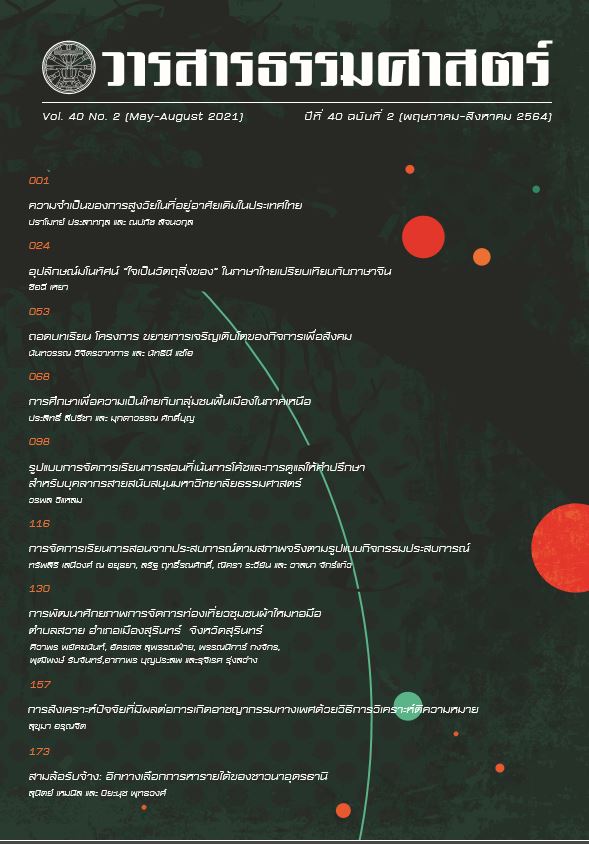The Essential of Ageing in Place in Thailand
Main Article Content
Abstract
Thailand is about to become a complete aged society by 2022, with the population aged 60 years and over accounts for 20 per cent of the total population. It is projected that, in the next 10 years, Thailand will step into a super-aged society where the population aged 60 years and over accounts for 28 percent of the total population. The key challenges posed by population ageing are income security, long-term care and housing for an ageing population. This article thus intends to point out why Thailand needs to adopt the concept of ageing in place as the main direction in guiding the design of policies on housing and caring for older persons, instead of focusing on institutional-based living. In addition, this article attempts to point out key elements that will make the concept of ageing in place possible and successful in Thai society: (1) place, (2) support network, and (3) individual. Such services shall be integrated and tailored to the demands of each community by taking different characteristics of older persons ( e. g. , age group, sex, living arrangement, dependency level and economic status) into account.
Article Details
References
Best, R. , & Porteus, J. (2012) . Housing our Ageing Population: Plan for Implementation. The All-Party Parliamentary Group on Housing and Care for Older People.
Bonnefoy, X. (2007). Inadequate Housing and Health: An Overview. International Journal of Environment and Pollution, 30(3/4), 411–429.
DWELL & University of Sheffield. (2015). “Extra-care Housing: Brief Development” (Draft, July 2015). https://dwell.group.shef.ac.uk/wp-content/uploads/2016/11/DWELL-ECH-Brief-dev-July-2015.pdf
Economic and Social Commission for Asia and the Pacific (ESCAP) . (2017) . Addressing the Challenges of Population Ageing in Asia and the Pacific: Implementation of the Madrid International Plan of Action on Ageing. https://www.unescap.org/publications/addressing-challenges-population-ageing-asia-and-pacific-implementation-madrid
European Union Agency for Fundamental Rights (FRA) . (2017) . Summary Overview of Types and Characteristics of Institutional and Community-based Services for Persons with Disabilities Available across the EU.
Hatcher, D. , Chang, E. , Schmied, V. , & Garrido, S. (2019) . Exploring the Perspectives of Older People on the Concept of Home. Journal of Aging Research, 2019, 1–10. https://doi.org/10.1155/2019/2679680
Hugman, R., & Campling, J. (1994) . Ageing and the Care of Older People in Europe. St. Martin’s Press.
Kane, R. L. (2000). Changing the Image of Long-term Care. Age and Ageing, 29(6).
Knapp, M., Cyhlarova, E., Comas-Herrera, A., & Lorenz-Dant, K. (2021). Crystallising the Case for Deinstitutionalisation: COVID-19 and the Experiences of Persons with Disabilities. Care Policy and Evaluation Centre, London School of Economics and Political Science. https://www.lse.ac.uk/cpec/ assets/documents/CPEC-Covid-Desinstitutionalisation.pdf
Organisation for Economic Co-operation and Development ( OECD) . (2020) . Long-Term Care Resources and Utilisation. https://stats.oecd.org/ Index.aspx?DataSetCode=HEALTH_LTCR
The Japan Times. (2021, April 10) . The Changing Face of Medical Care for Japan’s Older Residents amid COVID-19 |. https://www.japantimes.co.jp/news/2021/04/10/national/social-issues/health-care-seniors-covid-19-pandemic/
Tobis, D. (2000) . Moving from Residential Institutions to Community-based Social Services in Central and Eastern Europe and the Former Soviet Union. World Bank.
UNFPA Thailand. (2011). Impact of Demographic Change in Thailand. United Nations Population Fund Country Office in Thailand. United Nations. (2002). Political Declaration and Madrid International Plan of Action on Ageing. United Nations. https://www.un.org/
development/desa/ageing/madrid-plan-of-action-and-its-implementation.html
United Nations. (2019). World Population Prospects 2019 (Online Edition. Rev. 1). United Nations, Department of Economic and Social Affairs, Population Division. https://population.un.org/wpp/
United Nations, Department of Economic and Social Affairs, Population Division. (2019). World Population Ageing, 2019 Highlights ((ST/ESA/SER.A/430)).
Wiles, J. L., Leibing, A., Guberman, N., Reeve, J., & Allen, R. E. S. (2012). The Meaning of “Aging in Place” to Older People. The Gerontologist, 52(3), 357–366. https://doi.org/10.1093/geront/gnr098
World Health Organisation. (2015). World Report on Ageing and Health.
World Health Organisation. (2018) . Concept Note: International Technical Meeting AGING IN PLACE.https://extranet.who.int/agefriendlyworld/wp-content/uploads/2018/12/Concept-note.pdf
กรมกิจการผู้สูงอายุ. (2562). มาตรการขับเคลื่อนระเบียบวาระแห่งชาติ เรื่อง สังคมสูงอายุ (ฉบับปรับปรุง). กรมกิจการผู้สูงอายุ กระทรวงการพัฒนาสังคมและความมั่นคงของมนุษย์. https://www.dop.go.th/download/knowledge/th1551432930- 155_0.pdf
กรมกิจการผู้สูงอายุ. (ม.ป.ป.). เมื่อถึงวัย 60 ปี คุณจะได้สิทธิสวัสดิการอะไร. กรมกิจการ ผู้สูงอายุ.
กระทรวงการคลัง. (2564). จำนวนประกรสูงอายุที่มีบัตรสวัสดิการแห่งรัฐ พ.ศ. 2563.
ณปภัช สัจนวกุล, ณัฐนี อมรประดับกุล และ นุชราภรณ์เลี้ยงรื่นรมย์. (2564). รายงานการวิจัยฉบับสมบูรณ์เรื่อง การเรียนรู้นโยบายการสูงวัยในที่เดิมจากแนวปฏิบัติที่เหมาะสม: การถอดบทเรียนจากประสบการณ์ของประเทศญี่ปุ่นและสิงคโปร์สู่การ ขับเคลื่อนนโยบายด้านการจัดการที่อยู่อาศัยสำหรับผู้สูงอายุในประเทศไทย (สนับสนุนโดย สำนักงานการวิจัยแห่งชาติ). สถาบันวิจัยประชากรและสังคม มหาวิทยาลัยมหิดล.
ณัฐนี อมรประดับกุล, ณปภัช สัจนวกุล และ ปัณณวัฒน์ เถื่อนกลิ่น. (2563). นโยบายที่อยู่ อาศัยสำหรับผู้สูงอายุ: ประวัติศาสตร์และบทเรียนจากแนวปฏิบัติที่ดีในต่างประเทศ. สถาบันวิจัยประชากรและสังคม มหาวิทยาลัยมหิดล.
ไตรรัตน์ จารุทัศน์. (2561). การออกแบบเพื่อทุกคน. สำนักพิมพ์แห่งจุฬาลงกรณ์มหาวิทยาลัย.
ปราโมทย์ ประสาทกุล. (2563). เมื่อประชากรรุ่นเกิดล้านกลายเป็นผู้สูงอายุ. บทความเสนอต่อที่ประชุมราชบัณฑิตและภาคีสมาชิก สำนักธรรมศาสตร์และการเมือง ราชบัณฑิตยสภา วันที่ 10 มิถุนายน 2563.
มูลนิธิสถาบันวิจัยและพัฒนาผู้สูงอายุไทย (มส.ผส.). (2564). สถานการณ์ผู้สูงอายุไทย พ.ศ. 2563. สถาบันวิจัยประชากรและสังคม มหาวิทยาลัยมหิดล.
วรวรรณ ชาญด้วยวิทย์ และ ยศ วัชระคุปต์. (2560). ระบบประกันการดูแลระยะยาว: ระบบที่ เหมาะสมกับประเทศไทย. สถาบันวิจัยเพื่อการพัฒนาประเทศไทย.
วรเวศม์ สุวรรณระดา. (2557). ปฏิรูปบำนาญภาครัฐ-ก้าวสู่สังคมสูงวัยด้วยบำนาญอันมั่งคง และระบบการคลังที่ยั่งยืน. คณะเศรษฐศาสตร์ จุฬาลงกรณ์มหาวิทยาลัย.
สถาบันวิจัยประชากรและสังคม มหาวิทยาลัยมหิดล. (2560). พิพิธสาระประชากรและสังคม สาระที่ 3: ประชากรไทยในสมัยรัชกาลที่ 9. สถาบันวิจัยประชากรและสังคม มหาวิทยาลัยมหิดล.
สัมฤทธิ์ ศรีธำรงสวัสดิ์, ไพบูลย์ สุริยะวงศ์ไพศาล, วิชช์ เกษมทรัพย์, วิชัย เอกพลากร และ บวรศม ลีระพันธ์. (2561). รายงานวิจัยฉบับสมบูรณ์ โครงการวิจัยเพื่อพัฒนาระบบ การดูแลระยะยาว (Long-term care) สำหรับผู้สูงอายุที่มีภาวะพึ่งพิงภายใต้ระบบ หลักประกันสุขภาพแห่งชาติ. ภาควิชาเวชศาสตร์ชุมชน คณะแพทยศาสตร์ โรงพยาบาลรามาธิบดี.
สำนักงานสถิติแห่งชาติ. (2559). รายงานลักษณะของประชากร การสำรวจการเปลี่ยนแปลง ของประชากร พ.ศ. 2558-2559. สำนักงานสถิติแห่งชาติ.
สำนักงานสถิติแห่งชาติ. (2562). การสำรวจภาวะเศรษฐกิจและสังคมของครัวเรือน พ.ศ. 2561. สำนักงานสถิติแห่งชาติ.
สำนักงานสภาพัฒนาการเศรษฐกิจและสังคมแห่งชาติ. (2562). การคาดประมาณประชากร ของประเทศไทย พ.ศ. 2553-2583 (ฉบับปรับปรุง). สำนักงานสภาพัฒนาการ เศรษฐกิจและสังคมแห่งชาติ.
สำนักบริหารการทะเบียน กรมการปกครอง. (2563). สถิติประชากรทางการทะเบียนราษฎร. https://stat.bora.dopa.go.th/stat/statnew/statMONTH/statmonth/#/mai npage
สิรินทร์ยา พูลเกิด และ ณปภัช สัจนวกุล. (2563). ที่อยู่อาศัยที่เหมาะสมสำหรับผู้สูงอายุใน สังคมไทย: แนวคิด พัฒนาการ และมุมมองเชิงนโยบาย. สถาบันวิจัยประชากรและ สังคม มหาวิทยาลัยมหิดล.
อัจฉราวรรณ งามญาณ และ ณัฐวัชร์ เผ่าภู่. (2555). ผู้สูงอายุไทย: การเตรียมการทางด้าน การเงินและลักษณะบ้านพักหลังเกษียณที่ต้องการ. วารสารบริหารธุรกิจ, ปีที่ 35 (ฉบับที่ 136).

